|
|
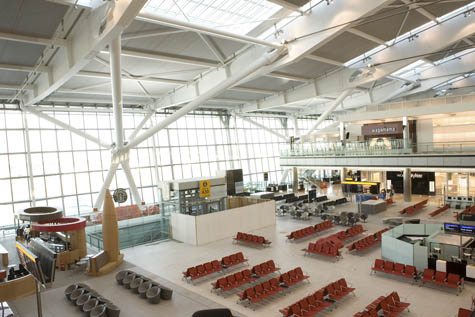 [Image: Heathrow Terminal 5, via Wikipedia]. [Image: Heathrow Terminal 5, via Wikipedia].Back in San Francisco, after a 12-hour delay at Heathrow's Terminal 5 in London. We sat on the first plane – there were three planes – for five hours before they realized that they couldn't start one of the engines; so we all filed back into the terminal while our luggage was loaded onto a second plane – which was then hit by a truck. A third airplane was thus conjured up out of the drizzling darkness of an otherwise abandoned international airport at midnight – I was reminded almost constantly of Iain Sinclair's description of Heathrow as "a Vatican of the western suburbs," a system of piazzas dedicated to geometric worship of the sky – and it rolled over to the gate to collect our bags, the lights in the cockpit still off. It was nearing 1am by then, we'd been given bags of sea-salted potato chips, and bad pop songs were playing on continuous loops through steel security grills pulled down in front of airport music shops. One or two obviously bored employees were performing day-end inventories on refrigerators full of Ribena at Boots, the guitarists for a band apparently based here in San Francisco were throwing an American football around with a kid called Nicholas, and if you stood at the edge of the glass-walled lightwells that cut all the way down to the ground in Richard Rogers's new terminal design you could watch under-oiled escalators squawking their way, from one side to the other, up the nearly five stories to arrive where we were all then sitting, filling out customer complaint forms. So thanks, British Air, for that odd glimpse of anthropology amidst well-engineered 21st-century architecture after everyone else had gone home – although I would've preferred to arrive twelve hours earlier, on time – and thanks, as well, to everyone who came out to see the variety of BLDGBLOG events last week in London. The other surprise worth mentioning is that, having landed at the misty, pre- BART hour of 4am, we had to take a taxi home – and as we drove up Fell Street our driver pointed out that gas prices have plunged to a somewhat unbelievable $1.79 a gallon.
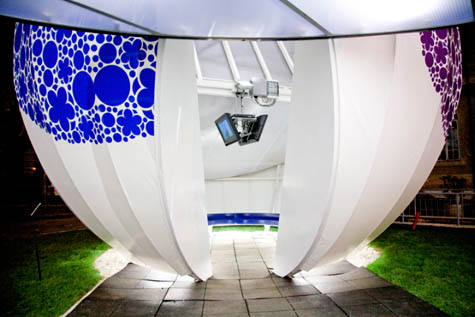 [Image: The Waiting Room, Rome, by Jeffrey Inaba/Inaba Projects]. [Image: The Waiting Room, Rome, by Jeffrey Inaba/Inaba Projects].Jeffrey Inaba of Inaba Projects has a new pavilion on display now in Rome, sponsored by Enel, Italy's largest utilities provider. Because of that sponsorship, Inaba "wanted to use numerous forms of alternative energy applications," but decided, in the end, to apply "just one that was highly productive and cost effective." The pavilion is thus solar-powered – Inaba describes it as an " Alice in Wonderland mushroom meets solar-ray chomping Pac-Man." 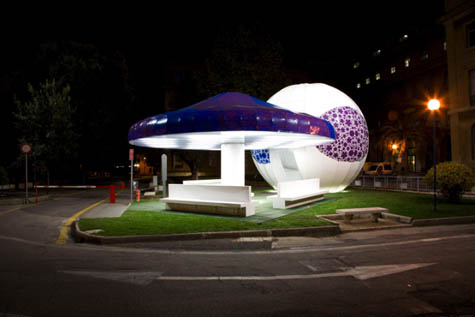  [Images: The Waiting Room, Rome, by Jeffrey Inaba/Inaba Projects]. [Images: The Waiting Room, Rome, by Jeffrey Inaba/Inaba Projects].So what is the project? Solar-powered and lit from within, with a DVD player and monitors, it tries to rethink the hospital waiting room; in fact, the cartoon-like, festive structure with a kind of external tattoo of abstract graphics, is "sited at Policlinico Umberto 1, Rome's largest public hospital, and one that has been recently controversial because of scandals of unsafe and unsanitary conditions." As an "enlightenment" era hospital, it was planned in a decentralized way, with specialities (pediatrics, respiratory maladies, contagious diseases) distributed throughout the campus, with no single central space. The project attempts to create a centralized space for all kinds of waiting (waiting for an appointment, to be picked up, the diagnosis of a loved one, for treatment, convalescing to recover). As Inaba himself explained in a recent issue of Art Review, the real purpose was “to create an environment to cope with our restlessness, if not through easing the irritation of having to wait, then at least through distraction from it." "The aim," Inaba writes in a short essay about the project, "is to produce a distraction from waiting by introducing a mix of people, activity and stimulation to thwart the inward feeling of inertia that is triggered by delays." Of course, this raises the possibility of a building so immersive, visually interesting, or simply distracting that you don't realize you're waiting for something. Time passes; nothing happens; you don't notice. It's a sort of anti-prison.   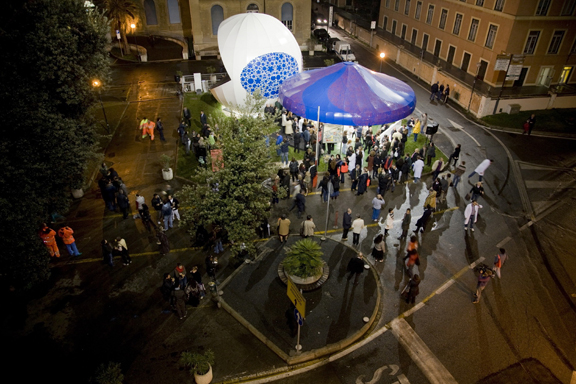 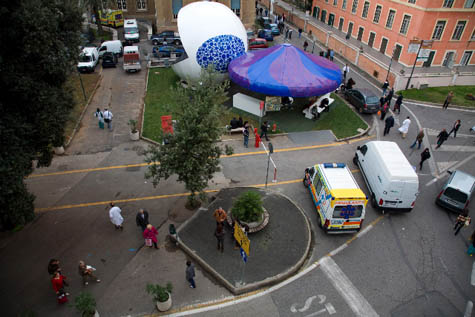 [Images: The Waiting Room, Rome, by Jeffrey Inaba/Inaba Projects]. [Images: The Waiting Room, Rome, by Jeffrey Inaba/Inaba Projects].The website for Enel Contemporanea adds that "[c]olours, lights, geometric shapes and various environmentally friendly elements" bring "an element of comfort to an architectural space normally seen as a temporary and highly emotional environment." 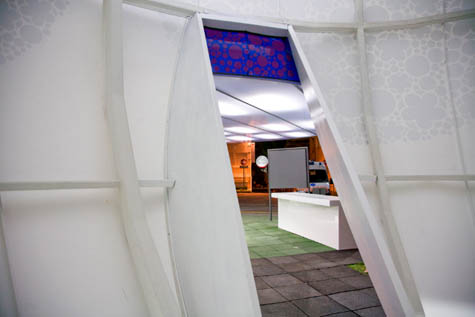  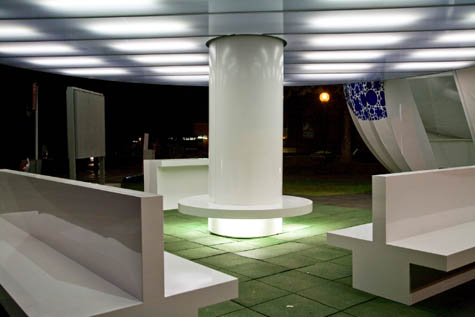  [Images: The Waiting Room, Rome, by Jeffrey Inaba/Inaba Projects]. [Images: The Waiting Room, Rome, by Jeffrey Inaba/Inaba Projects].All of which is another way of saying that the project enlivens the experience of waiting inside architecture – highlighting the general but overlooked surreality of the waiting room, as a space in which you simply wait for something else to happen.  [Image: The Waiting Room, Rome, by Jeffrey Inaba/Inaba Projects]. [Image: The Waiting Room, Rome, by Jeffrey Inaba/Inaba Projects].It's up until February 2009 – so if you're in Rome, check it out. [Earlier on BLDGBLOG: Trash Mandala].
A quick heads up that I'll be participating in a roundtable discussion tomorrow afternoon about "science fiction and architecture" at the Bartlett School of Architecture here in London. The participants are: It should make for an interesting conversation, with a great mix of perspectives on the intertwined topics of science fiction, built space, and the imagined environment, so do come out if you're in the neighborhood. The event lasts from 4-6pm, and it is free and open to the public. We'll be awaiting your arrival in Room G02, Wates House, 22 Gordon Street, London, WC1H 0QB. Here is a map. Of course, I'll then be moving down the street for the feral cities event at UCL tomorrow evening.
I'm in London, watching snowflakes fall amidst early morning rain flurries, reading David Grann's new book The Lost City of Z, and getting ready for the Barbican event tomorrow night. But there's an article in the Guardian today about the WaterMill, which "uses the electricity of about three light bulbs to condense moisture from the air and purify it into clean drinking water." The company, Element Four, imagines a future for their product involving everything from irrigation and personal thirst to peacekeeping and disaster relief. Perhaps it might even require an update to the atlas of hidden water – where the water supply is "hidden" in the sky itself.  [Image: A diagram of the WaterMill at work]. [Image: A diagram of the WaterMill at work].As the company describes it: The system draws in moist, outside air through an air filter. The moist air passes over a cooling element, condensing the moist air into water droplets. This water is then collected, passed through a specialized carbon filter and is then exposed to an ultraviolet sterilizer, eliminating bacteria. Further: The WaterMill is installed unobtrusively on the outside of your home, using outside air, so it won't dry out the air you breathe in your home. And don't worry if your outdoor air is less than pristine – even if you live in a crowded city, the Watermill's filtration system ensures your drinking water will be clean and free of toxins and bacteria – more pure than tap water or even spring water. You're basically drinking water from a dehumidifier, then. According to the Guardian, the obvious – if extremely uninteresting – next question is: "are you crazy?" But it would seem that the next question might actually be one of large-scale climate-engineering and the future of urban design. In other words, would it be possible to re-engineer a city's weather patterns through the judicious and geographically strategic deployment of WaterMills? What might happen if this were to occur accidentally, over time, and according to no particular plan? Over the years, say, tens of thousands – even millions – of these machines are installed in a humid city like New York, Tokyo, or London, achieving imperceptibly slow local climate modification. The city goes into a drought, with very little rainfall as humidity disappears – and it's all because of a certain line of products that have been installed, gradually, home by home, over the course of a decade. Sucking hundreds of thousands of liters of water out of the air everyday, and re-directing that water into the sewage system through the metabolic processes of human bodies, these machines inadvertently re-engineer the local climate. I remember walking to a restaurant through almost unbelievable summer humidity, thinking that massive, solar-powered air-conditioning units installed atop Manhattan skyscrapers could flood the surrounding streets with downward winds of cooled air to avoid uncomfortable nights – but industrial-sized WaterMills might accomplish the same thing, sitting up there in the heights of the marvelous, stealing water from the sky. Anti-clouds. Black engines atop roofs prevent rainfall. Whole summer storms could be stopped before they form. City-wide, temperatures drop and the humidity falters. The resulting fresh water is then sold to Spain. So if designer climates are the future of urban design, something explored in the forthcoming BLDGBLOG Book, then perhaps the widespread use of WaterMill technology might be an interesting way to start. Convince enough people in one large building, say, or even one borough, to install a home WaterMill... and see if the local climate begins to change.
 [Image: From Code 46, courtesy of United Artists (via)]. [Image: From Code 46, courtesy of United Artists (via)].Next week's event at the Barbican just got even better, with the addition of Mark Tildesley, production designer for Code 46, 28 Days Later, Sunshine, The Constant Gardener, 24 Hour Party People, Millions, and many others, including Richard Curtis's forthcoming film The Boat That Rocked. I'll be interviewing director Michael Winterbottom and Mark Tildesley both after a screening of their film Code 46. The event has already sold-out, but if you've got your ticket I hope you're in for a great conversation! For those of you who can't make it, the event will be videotaped and I should be able to host that on BLDGBLOG within a few weeks. Also, if you heard about the event here, come up and say hello – I'd love to see who's reading the site in London these days. More information: Code 46.
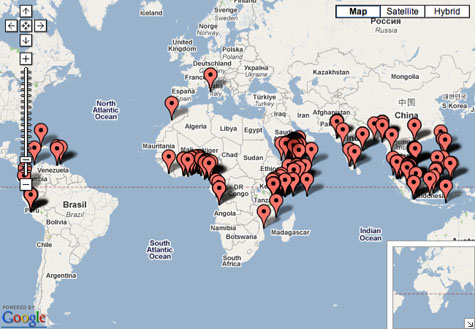 [Image: A screen-grab of the Live Piracy Map]. [Image: A screen-grab of the Live Piracy Map].With all the talk of piracy at sea, it was only a matter of time before the Live Piracy Map was developed. According to its creators, the map "shows all the piracy and armed robbery incidents reported to the IMB Piracy Reporting Centre during 2008." It's the geography of aquatic crime, mapping realtime adventures in buoyant larceny. 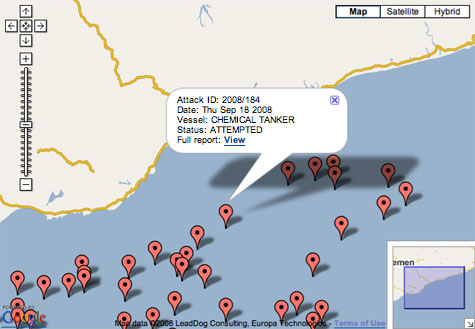 [Image: From the Live Piracy Map]. [Image: From the Live Piracy Map].This incident report corresponds to the map, above. The report describes the attempted hijacking of a chemical tanker: Two white hull boats with several persons onboard approached aggressively a chemical tanker underway with intent to board. Master raised alarm, increased speed, took evasive manoeuvres and contacted coalition forces. SSAS activated and crew mustered. The boats keep on following and at 0700 UTC, the boats aborted the attempt. These incident reports should be rewritten and assembled somewhere to form a new minor literature of the 21st-century sea; like Félix Fénéon's awesome Novels in Three Lines, each report will be a small masterpiece of plotting, set in the tidal landscapes of a feral coast. There will be heroes and antiheroes, evasions and threats. 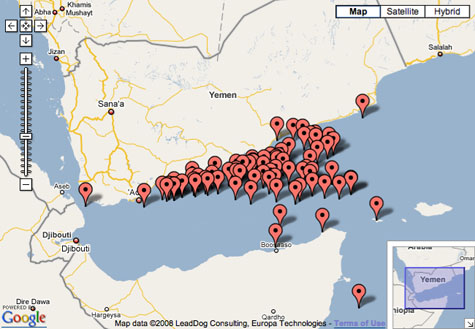 [Image: From the Live Piracy Map]. [Image: From the Live Piracy Map].Until then, just look up your favorite maritime hijacking via the Live Piracy Map – and wait till the next incident pops up. (Via Alexis Madrigal).
I've got two more events coming up in London, both on Wednesday, November 26. I'll post more info about the first event in a bit. The second one, in the evening, has been organized by the Complex Terrain Laboratory, and it will take place in the J.Z. Young Lecture Theatre at UCL, inside the Anatomy Building on Gower Street. Here is a map. 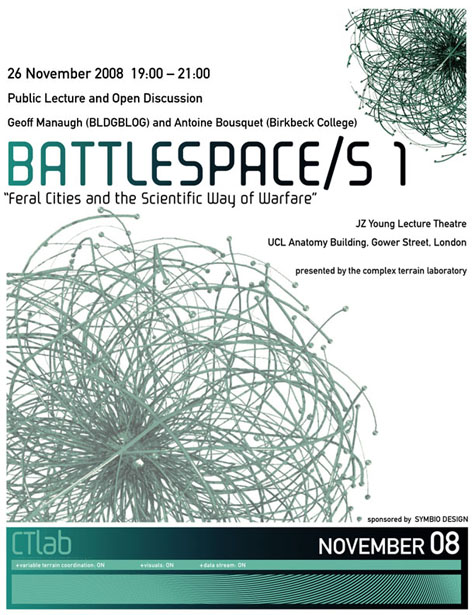 I'll be teaming up with Antoine Bousquet, Lecturer in International Relations at Birkbeck College, and author of the forthcoming book The Scientific Way of Warfare: Order and Chaos on the Battlefields of Modernity to discuss our work in relation to space, war, and the city. A description of the event itself: Contemporary political discourse on armed violence and insecurity has been largely shaped by references to spatial knowledge, simulation, and control: "human terrain," "urban clutter," "terrorist sanctuaries," "failed states," "core-periphery." The historical counterpoint to this is to be found in the key role the successive technologies of clock, engine, computer, and network have all played in spatializing the practice of warfare. In this context, what implications do "feral" Third World cities, "rogue" cities organized along non-Western ideas of urban space and infrastructure, and "wild" cities reclaimed by nature, have for the battlespaces of today and tomorrow? Antoine and I will both be giving short talks, followed by a general Q&A. The event is wide-open to the public, so please feel free to stop by. At the very least, you'll get an early preview of Antoine's forthcoming book – in which he introduces the term chaoplexic warfare in a survey of everything from ant "swarms" and the use of 18th-century battlefield metaphors to the distributed geographies of the Russian mafia, the Medellín drug cartel, and Al-Qaeda – and that's already quite a lot right there. For my own part, I'll be discussing a pretty broad swath of ideas about "feral cities" – what I like to call cities gone wild – ranging from Richard J. Norton's seminal paper on the topic to Mike Davis's research on "the Pentagon as global slumlord," via reference to J.G. Ballard, Eyal Weizman, Stefano Boeri, Reza Negarestani, and many others. I'll also briefly mention the radical ecology of a biologically wild city, or the city regressed (perhaps advanced?) into an extraordinary state of nature after abandonment and war.  Some of the basic themes we should be approaching: If a growing majority of the human population has now been urbanized, moving into what are often incorrectly described as "cities," what will warfare mean – and how will it be practiced – in these increasingly complex spatial environments? If urban insurgency is, indeed, the future of the global battlefield, as many theorists have proposed, how does the changing nature of urbanism itself help to redefine war? Conversely, how does insurrection work to redefine the space of the modern city? Finally, if the future of war can be seen as Military Operation on Urban Terrain – or MOUT – what mutations will we see when that one key variable, the urban, is redefined? So I'm really looking forward to this. I've got loads and loads of notes and references to bring with me, and it'll be good to meet Antoine, whose book I've been reading this month. So if you're in London that night, stop by! It's free and open to the public. Wild cities, rogue cities, feral cities, future cities. (Note: This event is sponsored by the excellent Symbio Design, who also produced our web banners, ads, and flyer).
On Monday, November 24, I'll be hosting a live interview at the Barbican in London with director Michael Winterbottom, for a special screening of his film Code 46. You can read a bit more about the event – as well as buy tickets – here. This is part of an ongoing series called Architecture on Film, curated by the Architecture Foundation. 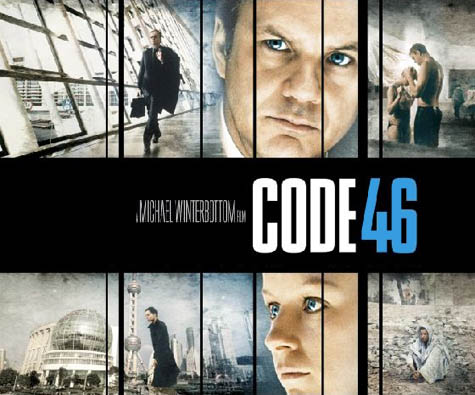 [Image: From Michael Winterbottom's Code 46, courtesy of United Artists]. [Image: From Michael Winterbottom's Code 46, courtesy of United Artists].The purpose of the event is to talk about film and architecture – or, in this case, cities, urban design, memory, science fiction, landscape, globalization, and the built environment. As you can see from the list of locations used for the film's production, Code 46 is very well-traveled, stitching together urban – and exurban – environments from London, Shanghai, Dubai, Hong Kong, and even the deserts of Rajasthan. That the film achieves the feel of science fiction simply through a well-edited depiction of existing landscapes says as much about the film as it does about the nature of city-building today; perhaps one might only half-jokingly suggest that people build cities today in order to live inside science fiction films. 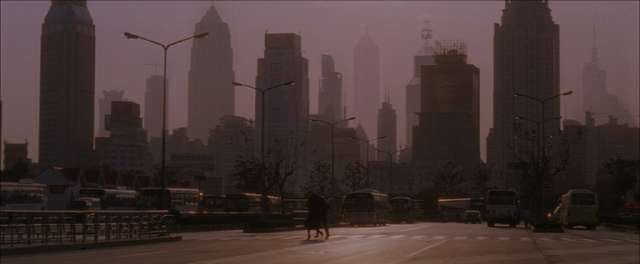 [Image: Shanghai, from Code 46, directed by Michael Winterbottom, courtesy of United Artists]. [Image: Shanghai, from Code 46, directed by Michael Winterbottom, courtesy of United Artists].As BLDGBLOG explored the other week in a long post, "cities today are well known for popping up in the middle of nowhere, history-less and incomprehensible." That’s what cities now do. If these cities are here today, they weren’t five years ago; if they’re not here now, they will be soon. Today’s cities are made up, viral, fungal, unexpected. Like well-lit film sets in the distance, staged amidst mudflats, reflecting themselves in the still waters of inland reservoirs, today’s cities simply arrive, without reservations; they are not so much invited as they are impossible to turn away. Cities now erupt and linger; they are both too early and far too late. Cities move in, take root and expand, whole neighborhoods throwing themselves together in convulsions of glass and steel. What does it mean, then, to set a film inside a mix of such spaces? And as more and more instant cities appear in the world, built from zero in less than a decade, how can cinema capitalize on the lack of recognition these historically too-new and culturally all but anonymous environments inspire? What does it mean, as well, that the depiction of the future in Code 46 – a depiction of the future through architecture – involves no U.S. cities at all and only very brief glimpses of urban infrastructure in Europe? 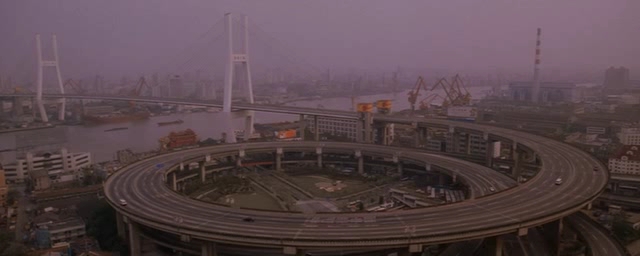 [Image: Shanghai, from Code 46, directed by Michael Winterbottom, courtesy of United Artists]. [Image: Shanghai, from Code 46, directed by Michael Winterbottom, courtesy of United Artists].This brings up one of the more interesting aspects of the film – something not internal to it, but created by the current state of global urbanization. The film makes it deliberately unclear, in other words, that it was shot in multiple locations at all; the opening sequence blurs together landscapes, buildings, and infrastructures from very different cities – yet this unfamiliar new place to which we're being introduced might very well exist. For all many viewers know, perhaps Shanghai really is in the middle of a desert; perhaps Dubai really does look exactly like Hong Kong. This confusion only seems possible, however, within a very narrow window of historical time. As the skylines and iconic hotel interiors of Dubai, Shanghai, Hong Kong, and elsewhere become visually familiar to many more people, it will become much harder to do what Code 46 has done – which is to edit them all up into a convincing pastiche. They are a spatial collage, an urban cut-up – William S. Burroughs as architectural director. In ten years, then, would this be akin to cutting from a shot of the Empire State Building to a shot of the Eiffel Tower and pretending that these landmarks are in the same city – only to find that almost no one has been genuinely tricked? In a funny but negative Amazon review of the film, a disappointed viewer actually mocks this very aspect: "If I have to keep seeing these movies with the I haven't a clue which Metro I'm in look I'm going to scream." But what does it mean that Asian cities – cinematically depicted as a kind of monolithic urban Other – are, for the time being, so visually unfamiliar to Western audiences that they can be edited into a seamless Global Metropolis, a vast agglomeration of spatial alterity that we can cut-and-paste together on film? Where might Code 46 have been made if it had been produced fifteen years from now? What explosive urban outgrowths between now and then will be sufficiently unfamiliar to literally hundreds of thousands of filmgoers that they could be combined into one convincing location? Will the sci-fi films of tomorrow be set in Lagos, Delhi, Rabat, or Shenzhen? All of the above? It's the future science fiction of global third-tier urbanism. For instance, one of the most striking aspects of the urban environment in The Matrix came simply from the fact that many – though not all – of the outdoor scenes were shot in Sydney, a city with which most American viewers are not visually familiar. The urban world of the Matrix thus took on an uncanny sense of near-resemblance, looking an awful lot like a city everyone has seen before – is that Houston? Tampa Bay? Fresno? – but not enough like any single one of them to be clear. The film Primer, shot in Dallas, is an amazing example of this: the whole time you're watching it you have no idea where you are... though absolutely everything about it looks familiar. The effect, particularly in Code 46, is almost literally uncanny. 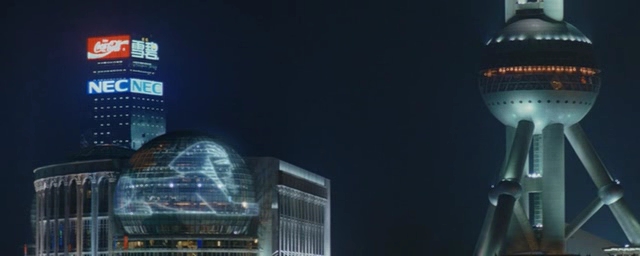 [Image: The Shanghai skyline, from Code 46, directed by Michael Winterbottom, courtesy of United Artists]. [Image: The Shanghai skyline, from Code 46, directed by Michael Winterbottom, courtesy of United Artists].Briefly, I'm also reminded here of Tativille, the massive film-set city built by Jacques Tati to produce his own film Playtime. Constructed solely for the purpose of hosting camera crews – and later disassembled – Tativille was a city of the image, its design shaped only by how it would look on screen. With Tativille in mind, what might future audiences think if, say, Dubai really does run out of money in the global economic downturn, its towers abandoned and eroding back to sand? It will be visible in films like Code 46 – but nowhere else. It will have ceased to exist. It will have been a kind of Tativille of the Emirates, built only to host film crews and car commercials. In any case, the film's visions of desert poverty – scenes in Rajasthan – and desert opulence – scenes in Dubai – bring up the topic of uneven development. If, as William Gibson's oft-quoted line goes, the future is already here, it's just unevenly distributed, then this also appears to be true in the context of architectural form and urban landscapes. But which one is the future: the nationless desert of rights-deprived exiles or the golf course-filled desert of the stateless business class? Or are these perhaps one and the same, requiring each other as the flipsides of their own formation?  [Image: The opening titles of Michael Winterbottom's Code 46, courtesy of United Artists]. [Image: The opening titles of Michael Winterbottom's Code 46, courtesy of United Artists].None of these questions are new, of course, going back in some form or another to Sergei Eisenstein, Fredric Jameson, and many, many others; but the opportunity to discuss all this with Michael Winterbottom himself in reference to a specific – and, as it happens, visually stunning – film, in a monumental and legendary architectural complex like the Barbican, is something of which I'm genuinely excited to be a part. So if you're in London on Monday, November 24, consider stopping by. Tickets can be purchased directly through the Barbican's website, and you can learn a bit more about the film here.
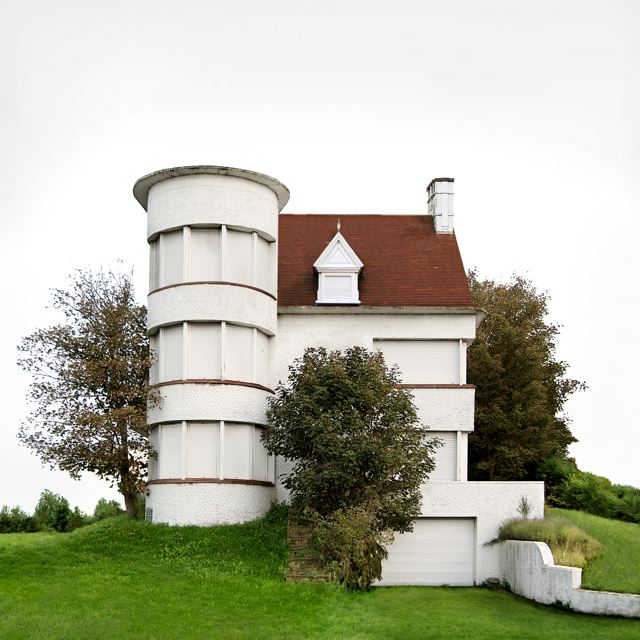 [Image: Photo by Filip Dujardin, courtesy of the artist]. [Image: Photo by Filip Dujardin, courtesy of the artist].Belgian photographer Filip Dujardin makes images of unexpected buildings – that is, he "combines photographs of parts of buildings into new, fictional, architectonic structures," Mark Magazine explains. The resulting projects look like old factory sites in the American rust belt – Mark describes them as "informal and often dilapidated structures with unspecified functions" – or, in some cases, new projects by LOT-EK, Simon Ungers, or OMA.  [Image: Photo by Filip Dujardin, courtesy of the artist]. [Image: Photo by Filip Dujardin, courtesy of the artist].From Mark Magazine: Every montage, says Dujardin, is one project. It begins with an idea for a specific image. Often he starts off by building a model of the form he is trying to achieve – at first in cardboard, but he has recently discovered SketchUp. He then goes on a photo safari, often just around the corner, to find suitable buildings "with a lot of the same things," so that they can be cut and pasted and serve as building material. In fact most of the fictional structures are buildings in Ghent, just resampled There seem to be multiple sub-themes, and even sub-projects, within the larger effort. There are surreal detached structures, for instance, like the image that opens this post, standing free amidst a recognizable but anonymous landscape. In some of these we see that even geological forms become subject to resampling. 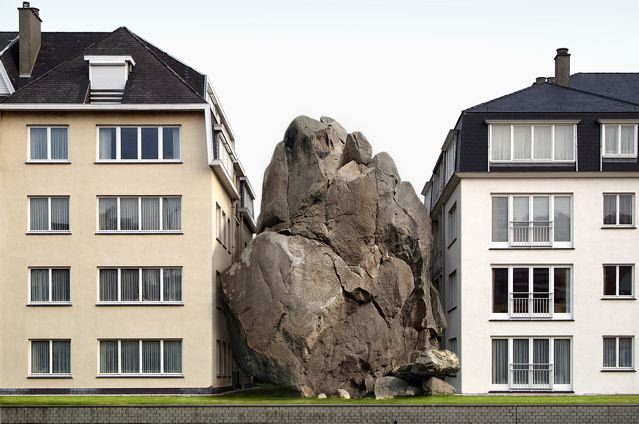 [Image: Photo by Filip Dujardin, courtesy of the artist]. [Image: Photo by Filip Dujardin, courtesy of the artist].But then there are also what could be called a back series – that is, the backs of incredible buildings whose facades you can barely imagine. These are groves of architecture, weird islands of form, like the city as seen from a rail line: sheds and retaining walls, stained by rain, their bricks chipped away behind piles of rubbish, their corrugated steel repeating ever onward in infinite ridges. 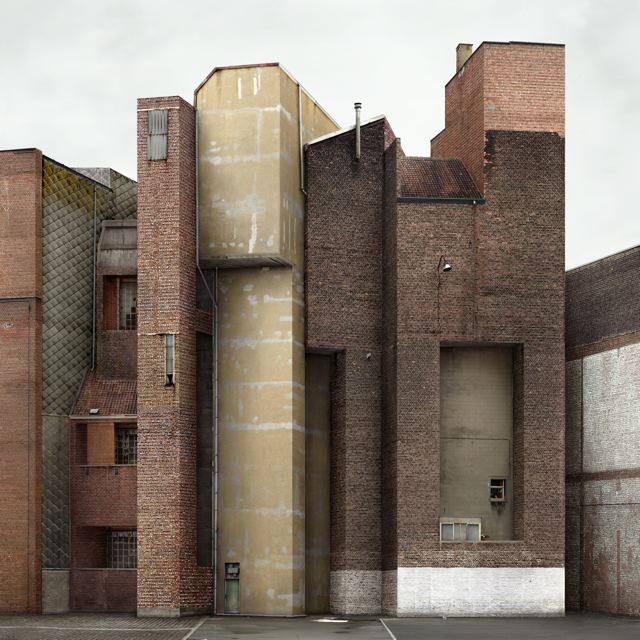  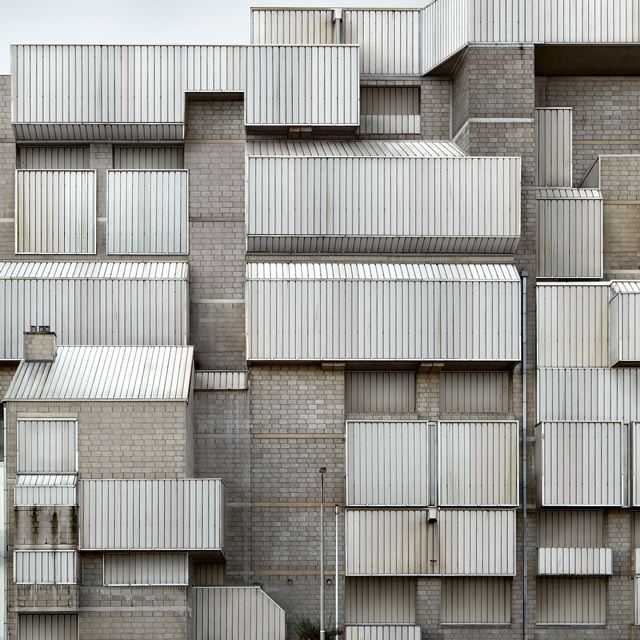 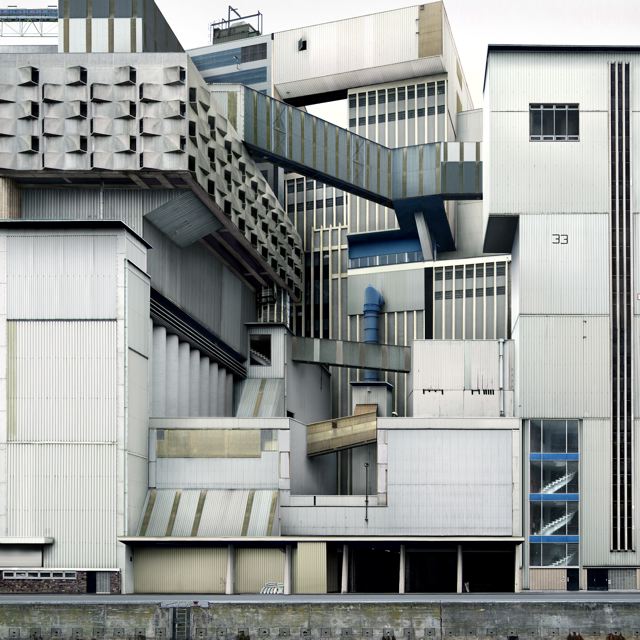 [Images: Photos by Filip Dujardin, courtesy of the artist]. [Images: Photos by Filip Dujardin, courtesy of the artist].Then there are Dujardin's relatively well-known images of impossible structures, buildings made from ambitious cantilevers and strained central masts. They form vertical braidworks of halls and corridors woven through the sky above otherwise empty parks and dead fields.  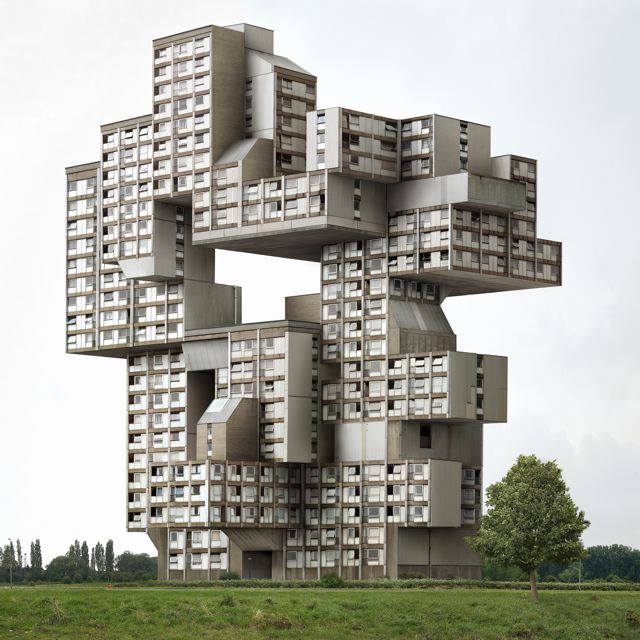 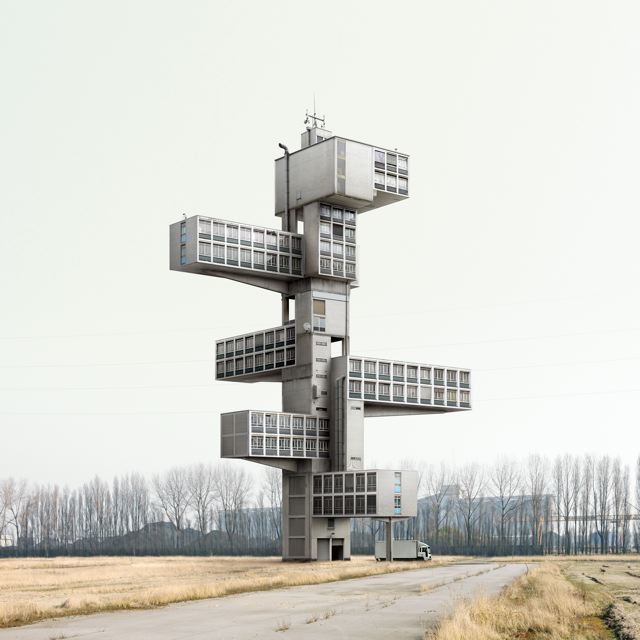 [Images: Photos by Filip Dujardin, courtesy of the artist]. [Images: Photos by Filip Dujardin, courtesy of the artist].As Dujardin comments to Mark Magazine, "Perhaps the works come out of frustration. That I actually want to play at being an architect, instead of only recording the buildings of others." You can read more about the photographer on his website. 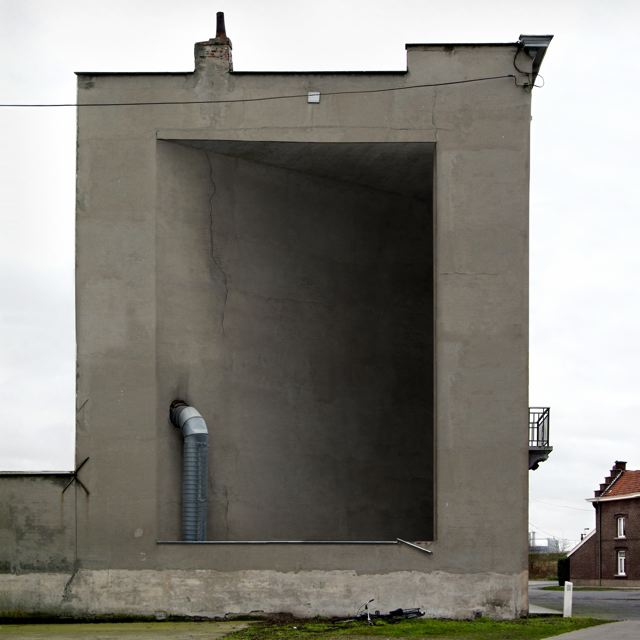 [Image: Photo by Filip Dujardin, courtesy of the artist].(Related: Fictional ruins from fictional worlds). [Image: Photo by Filip Dujardin, courtesy of the artist].(Related: Fictional ruins from fictional worlds).
|
|
 [Image: Heathrow Terminal 5, via Wikipedia].
[Image: Heathrow Terminal 5, via Wikipedia].
 [Image: The Waiting Room, Rome, by Jeffrey Inaba/
[Image: The Waiting Room, Rome, by Jeffrey Inaba/
 [Images: The Waiting Room, Rome, by Jeffrey Inaba/
[Images: The Waiting Room, Rome, by Jeffrey Inaba/


 [Images: The Waiting Room, Rome, by Jeffrey Inaba/
[Images: The Waiting Room, Rome, by Jeffrey Inaba/


 [Images: The Waiting Room, Rome, by Jeffrey Inaba/
[Images: The Waiting Room, Rome, by Jeffrey Inaba/ [Image: The Waiting Room, Rome, by Jeffrey Inaba/
[Image: The Waiting Room, Rome, by Jeffrey Inaba/ [Image: A diagram of the
[Image: A diagram of the  [Image: From
[Image: From  [Image: A screen-grab of the
[Image: A screen-grab of the  [Image: From the
[Image: From the  [Image: From the
[Image: From the  I'll be teaming up with
I'll be teaming up with  Some of the basic themes we should be approaching: If a growing majority of the human population has now been urbanized, moving into what are often incorrectly described as "cities," what will warfare mean – and how will it be practiced – in these increasingly complex spatial environments? If urban insurgency is, indeed, the future of the global battlefield, as many theorists have proposed, how does the changing nature of urbanism itself help to redefine war? Conversely, how does insurrection work to redefine the space of the modern city?
Some of the basic themes we should be approaching: If a growing majority of the human population has now been urbanized, moving into what are often incorrectly described as "cities," what will warfare mean – and how will it be practiced – in these increasingly complex spatial environments? If urban insurgency is, indeed, the future of the global battlefield, as many theorists have proposed, how does the changing nature of urbanism itself help to redefine war? Conversely, how does insurrection work to redefine the space of the modern city?  [Image: From Michael Winterbottom's
[Image: From Michael Winterbottom's  [Image: Shanghai, from
[Image: Shanghai, from  [Image: Shanghai, from
[Image: Shanghai, from  [Image: The Shanghai skyline, from
[Image: The Shanghai skyline, from  [Image: The opening titles of Michael Winterbottom's
[Image: The opening titles of Michael Winterbottom's  [Image: Photo by
[Image: Photo by  [Image: Photo by
[Image: Photo by  [Image: Photo by
[Image: Photo by 


 [Images: Photos by
[Images: Photos by 

 [Images: Photos by
[Images: Photos by  [Image: Photo by
[Image: Photo by 


